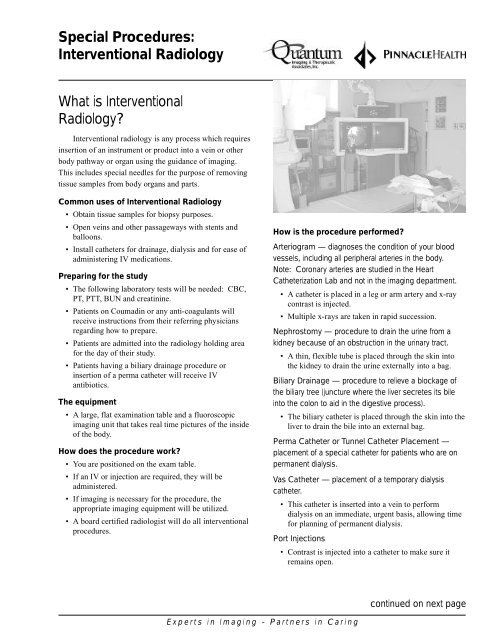What is Interventional Radiology? Special Procedures ...
What is Interventional Radiology? Special Procedures ...
What is Interventional Radiology? Special Procedures ...
You also want an ePaper? Increase the reach of your titles
YUMPU automatically turns print PDFs into web optimized ePapers that Google loves.
<strong>Special</strong> <strong>Procedures</strong>:<br />
<strong>Interventional</strong> <strong>Radiology</strong><br />
<strong>What</strong> <strong>is</strong> <strong>Interventional</strong><br />
<strong>Radiology</strong><br />
<strong>Interventional</strong> radiology <strong>is</strong> any process which requires<br />
insertion of an instrument or product into a vein or other<br />
body pathway or organ using the guidance of imaging.<br />
Th<strong>is</strong> includes special needles for the purpose of removing<br />
t<strong>is</strong>sue samples from body organs and parts.<br />
Common uses of <strong>Interventional</strong> <strong>Radiology</strong><br />
• Obtain t<strong>is</strong>sue samples for biopsy purposes.<br />
• Open veins and other passageways with stents and<br />
balloons.<br />
• Install catheters for drainage, dialys<strong>is</strong> and for ease of<br />
admin<strong>is</strong>tering IV medications.<br />
Preparing for the study<br />
• The following laboratory tests will be needed: CBC,<br />
PT, PTT, BUN and creatinine.<br />
• Patients on Coumadin or any anti-coagulants will<br />
receive instructions from their referring physicians<br />
regarding how to prepare.<br />
• Patients are admitted into the radiology holding area<br />
for the day of their study.<br />
• Patients having a biliary drainage procedure or<br />
insertion of a perma catheter will receive IV<br />
antibiotics.<br />
The equipment<br />
• A large, flat examination table and a fluoroscopic<br />
imaging unit that takes real time pictures of the inside<br />
of the body.<br />
How does the procedure work<br />
• You are positioned on the exam table.<br />
• If an IV or injection are required, they will be<br />
admin<strong>is</strong>tered.<br />
• If imaging <strong>is</strong> necessary for the procedure, the<br />
appropriate imaging equipment will be utilized.<br />
• A board certified radiolog<strong>is</strong>t will do all interventional<br />
procedures.<br />
How <strong>is</strong> the procedure performed<br />
Arteriogram — diagnoses the condition of your blood<br />
vessels, including all peripheral arteries in the body.<br />
Note: Coronary arteries are studied in the Heart<br />
Catheterization Lab and not in the imaging department.<br />
• A catheter <strong>is</strong> placed in a leg or arm artery and x-ray<br />
contrast <strong>is</strong> injected.<br />
• Multiple x-rays are taken in rapid succession.<br />
Nephrostomy — procedure to drain the urine from a<br />
kidney because of an obstruction in the urinary tract.<br />
• A thin, flexible tube <strong>is</strong> placed through the skin into<br />
the kidney to drain the urine externally into a bag.<br />
Biliary Drainage — procedure to relieve a blockage of<br />
the biliary tree (juncture where the liver secretes its bile<br />
into the colon to aid in the digestive process).<br />
• The biliary catheter <strong>is</strong> placed through the skin into the<br />
liver to drain the bile into an external bag.<br />
Perma Catheter or Tunnel Catheter Placement —<br />
placement of a special catheter for patients who are on<br />
permanent dialys<strong>is</strong>.<br />
Vas Catheter — placement of a temporary dialys<strong>is</strong><br />
catheter.<br />
• Th<strong>is</strong> catheter <strong>is</strong> inserted into a vein to perform<br />
dialys<strong>is</strong> on an immediate, urgent bas<strong>is</strong>, allowing time<br />
for planning of permanent dialys<strong>is</strong>.<br />
Port Injections<br />
• Contrast <strong>is</strong> injected into a catheter to make sure it<br />
remains open.<br />
continued on next page<br />
E x p e r t s i n I m a g i n g - P a r t n e r s i n C a r i n g
<strong>Special</strong> <strong>Procedures</strong>:<br />
<strong>Interventional</strong> <strong>Radiology</strong><br />
continued<br />
AV F<strong>is</strong>tulagrams and Declot Embolectomy — to<br />
d<strong>is</strong>cover stenoses (strictures or narrowing) or clots in<br />
body pathways.<br />
• A contrast agent <strong>is</strong> injected.<br />
• The radiolog<strong>is</strong>t will break up the clot in an attempt to<br />
open the f<strong>is</strong>tula (abnormal passageway from one area<br />
to another).<br />
• Balloon angioplasty may be performed to open the<br />
narrowed area.<br />
Lumbar and Cervical D<strong>is</strong>cograms — determines which<br />
spinal d<strong>is</strong>c space <strong>is</strong> causing a patient’s pain.<br />
• A saline solution <strong>is</strong> injected into a d<strong>is</strong>c space to<br />
attempt duplicating a patient’s symptoms.<br />
• The patient must be alert and communicating with the<br />
radiolog<strong>is</strong>t throughout th<strong>is</strong> study.<br />
E x p e r t s i n I m a g i n g - P a r t n e r s i n C a r i n g
















